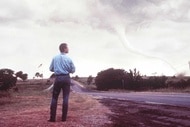Create a free profile to get unlimited access to exclusive videos, sweepstakes, and more!
Report: Visitors to Grand Canyon National Park museum may have been exposed to high levels of radiation for years

A new report from azcentral.com is alleging that visitors and employees to the Grand Canyon National Park museum in Nevada have been exposed to nuclear radiation for years.
Last summer, it was discovered that containers chock full of radioactive uranium ore were simply sitting next to a taxidermy exhibit; one was reportedly so full, that its lid would not close. While these were promptly removed by the government, the park's director of safety and wellness, Elston "Swede" Stephenson, claims that neither the public nor the workers were warned about being exposed to radiation without them knowing.
"If you were in the Museum Collections Building (2C) between the year 2000 and June 18, 2018, you were 'exposed' to uranium by OSHA's definition," Stephenson wrote in an email to staff on Feb. 4. "The radiation readings, at first blush, exceeds (sic) the Nuclear Regulatory Commission's safe limits. … Identifying who was exposed, and your exposure level, gets tricky and is our next important task."
Believing a cover-up to be taking place at the highest levels of management, Stephenson took his case to the federal government, contacting Acting Interior Secretary David Bernhardt and Deputy Inspector General Mary Kendall.
"Respectfully, it was not only immoral not to let Our People know," he wrote to them on Feb. 11. "But I could not longer risk my (health and safety) certification by letting this go any longer."
Since tours (many of them made up of groups of children) stop by the exhibit for 30 minutes or more, Stephenson voiced his concern that visitors were being exposed to amounts of radiation that go well beyond the acceptable limit: 400 times the limit for adults and 4,000 times the limit for children.
Emily Davis, a public affairs specialist for the Grand Canyon National Park, provided SYFY WIRE with an official release, which states that an investigation is being conducted by The National Park Service (NPS) and the Department of the Interior (DOI).
"Visitor and employee safety is our top priority," said Grand Canyon National Park Acting Superintendent Lisa Carrico in a statement. "We take this matter very seriously and the National Park Service and Department of the Interior have moved to assemble the appropriate interagency health and safety specialists to determine possible safety concerns, and clarify the relevant facts regarding this issue."
Results of the investigation — which involves a team of radiation, industrial hygienist, and occupational health experts — will hopefully be made available over the next 90 days or so.
The vacant deserts of the American West are notorious as the original testing sites of the first-ever atomic bombs during and after World War II. Indeed, the main site of the Manhattan Project was based out of Los Alamos, New Mexico. Testing also took place in less-populated areas of the Pacific Ocean like Bikini Atoll, which served as the detonation site for the much more powerful hydrogen bomb in the 1950s.
After the release of RKO's The Conquerer in 1956 (which starred John Wayne as Genghis Khan), cast members began to be diagnosed with and die of cancer. Filming for the Howard Hughes-produced movie was shot in Utah near a spot used by the government to test nuclear weapons just three prior to production taking place.
However, the government assured the filmmakers that the area was safe to use. In time, the film became known as "an RKO Radioactive Picture." Prior to his death, Hughes bought up all the copies of The Conquerer; some say he did this because he was guilty over putting so many people at risk of radiation sickness and cancer.
(The Conquerer intel via The Guardian)


























